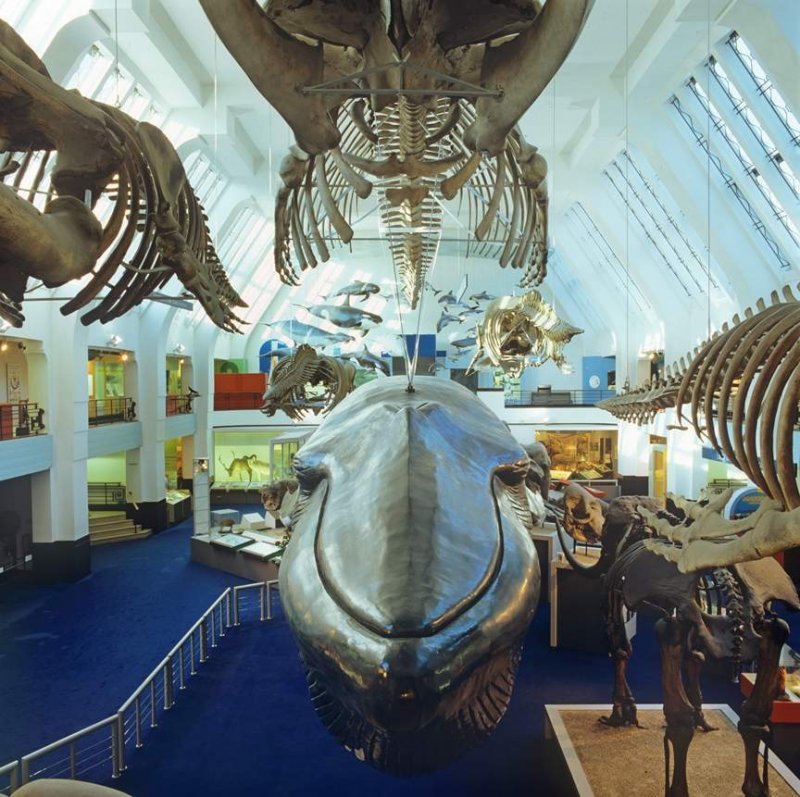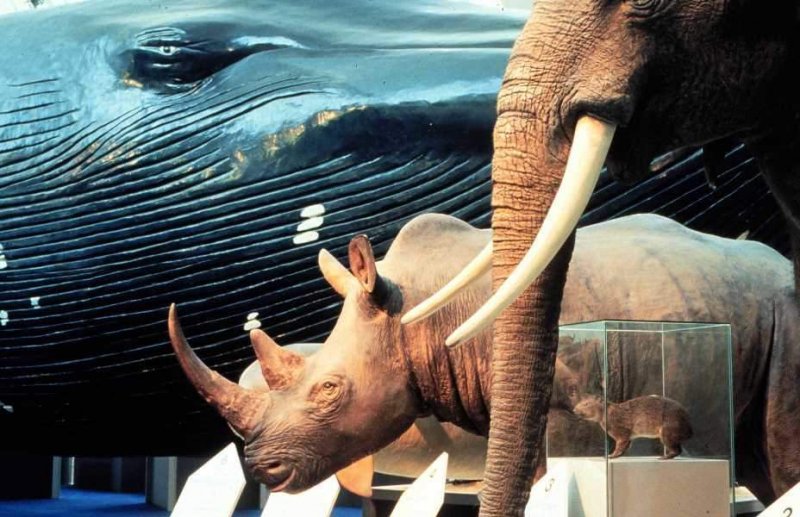On 25 March 1891, a female blue whale was harpooned by a whaling vessel and fatally injured. She was in the Irish sea, and ended up beached on a sandbank at the entrance of Wexford Harbour, on the south-east Irish coast.
Local fishermen discovered her floundering and thrashing around, four-and-a-half times the size of their boat, significantly taller, and more than 25 metres long. They had never seen a creature this size. A fisherman called Ned Wickham eventually put her out of her misery with a blade, and, according to contemporary reports, “succeeded in dispatching the big fish”.

The blue whale skeleton, c.1950-74. Photo: © Trustees of the NHM, London
Over 126 years later, and that same creature that caught a handful of fishermen’s attention will be seen by millions. Her 4.5 tonne skeleton is going on display in London’s Natural History Museum entrance hall, replacing the traditional Diplodocus cast in the grand Hintze Hall. It’s a controversial move. Dippy – who received his nickname from an adoring public – is an iconic part of the Natural History Museum’s history, wowing visitors since 1905.
A special panel of collection managers, curators and scientists was put together to choose Dippy’s replacement. Specialists across the museum were invited to make a case for their preferred exhibits.
Richard Sabin, the resident whale expert, won them over. “What makes a specimen iconic? Will our blue whale skeleton become iconic?” he frets, when I meet him before the skeleton is unveiled. “I think so. It can’t fail to be, because of its very nature, but also because of where it is in the museum’s history and what we’re actively doing, in the field, with our researching.”
“It’s an interesting one because Dippy is of course part of people’s memories, childhood, and bringing their own children and so on,” he adds. He admits that his specimen of choice doesn’t even have a name – it’s been “lost over the years” – but says it’s “inevitable that she’ll get a nickname” now.

What the skeleton will look like in Hintze Hall. Photo: ® 2015 Casson Mann
Sabin, 51, is a marine mammal curator, and has been working at the Natural History Museum for 25 years, where he’s the collections manager for the vertebrates division. But wandering among the Victorian grandeur in his camouflage hoodie, blue jeans and battered trainers, you wouldn’t tell that he is one of the museum’s senior figures.
We enter a dimly lit hall closed off to the public, where the exhibition for the Natural History Museum’s special whale season – which opens this week, along with Hintze Hall’s new resident – is being prepared. With its high brick arched ceiling and stained glass windows, it has the hushed atmosphere of a church. It is here that exhibitions are prepared before going on show.
Specimens, lit up and attended to by blue lab-coated conservators, loom out of the gloom like stalagmites. The corkscrew-shaped jaw of a deformed sperm whale; the rib cage of a bottle-nosed dolphin; giant toothed whale skulls gazing up at the ceiling – some with bandages, others being cleaned with cotton buds.

A whale conservator working on a flipper. Photo: © Trustees of the NHM, London
“When they [visitors] leave the exhibition, we want them to have connected with whales and dolphins in an emotional way, but a way that hopefully makes them want to take some kind of an action,” Sabin says, referring to marine exploitation and mankind’s gruesome whale-hunting past.
The Wexford whale was discovered just before the rise of commercial whaling, and a decade ahead of the industry dominating the Irish coast. She was on one of the last migrations of blue whales unthreatened by an industry that would come to endanger the species by turning them into oil, soap, perfume, candles, margarine, corsets and even umbrellas.
Although Sabin has been working on this exhibition for years, he looks wide-eyed at the assorted bones and skulls with boyish delight. Aside from his white hair and grey speckled stubble, he probably had the same expression when he first visited the Natural History Museum on a school trip at ten years old.
It was then that he first saw the Wexford whale skeleton. Until last year, it was suspended above the museum’s world famous blue whale replica.
“My first and overwhelming memory of the museum was the whale hall,” Sabin grins, as we walk towards it through the echoing corridors. The blue whale replica is especially sign-posted. “You walk in at ground level as a tiny child and you’re just presented with a wall of blue. And then you look up above the blue whale model and you see all the other skeletons. That was really the memory that I took away from the museum back then.”


The blue whale replica with the skeleton above. Photo: © Trustees of the NHM, London
Sabin remembers asking a gallery attendant if the blue whale, suspended like a big blue zeppelin from the ceiling, was real. She said no. And so he asked about the Wexford skeleton above it, where it had been until last year. She told him it was genuine, and that these animals were still out there in the ocean. “My imagination just went off on one,” he recalls.
As a child, Sabin was fascinated by bones. He used to collect roadkill from a main road near where he grew up in north Birmingham, and bring it home. His “very understanding parents” let him have a little patch of ground at the bottom of the garden to bury the carcasses, “so I could rot away the flesh and look at the bones”, he explains.
“I wanted to know what was inside these animals. I wanted to know how they moved and how they supported themselves.”
When he returned to the museum in 1981, having just finished school, he says he was “absolutely sold”. He applied for an archaeology degree, specialising in osteology, at Sheffield University, and then ended up working with marine mammals.
We gaze at the blue whale replica from a viewing gallery. Its ridged jaw slopes up at such an angle that it appears to be half smiling, its tiny eyes creased. It has been here since 1938. It is the first lifesize scale model of a blue whale ever built, at 29 metres long (later, the Smithsonian in Washington DC would build theirs a few inches longer to make it the biggest in the world). We now know that it’s inaccurately rotund, but that doesn’t stop it stunning first-time visitors.


The whale hall. Photo: © Trustees of the NHM, London
Most children who see it for the first time share the schoolboy Sabin’s reaction – we can hear them gasping and shrieking below as we speak. I remember being flabbergasted by its size when I visited on a school trip; I’d never realised – and can still hardly comprehend – that such large creatures exist. A model like this brings it to life more than any documentary I’ve seen.
Although our ancestors’ thirst for replication has fallen out of fashion, we have them to thank for these reactions. Models such as this one make scientific research part of our cultural memory, as well as a key part of the museum’s body of research. This makes the study of science more accessible, Sabin believes. From the meticulous collecting and cataloguing of the Victorian era to the modern push for digitising the museum’s vast data records, it’s about bringing information to everyone, whatever their background. “I am a great proponent of that, because as a child, visiting London for the first time on a school trip from Birmingham, we didn’t really have a lot of resources at my school.”
Sabin was brought up in a working-class household; his father was a lorry driver and his mother worked in a factory. “It was a good life, but not a family with a huge amount of cash; we had holidays to Wales every other year in a caravan,” he says. “It was borderline for me whether I went on that school trip in 1976, because money was a bit tight.”
But it was his last year of primary school, and “it was the big trip,” he recalls. “So my parents were like he’s got to go to London to see these things, but it’s not always the case that people are able to do that.” For this reason, Dippy will be taken on a tour around the country, hoping to attract five million new viewers.
Hundreds of people affected by their first impressions of the blue whale replica have told Sabin their stories. A woman whose mother ran a nearby coffee shop in the 1950s used to visit it every morning as a child. She told him about a security guard walking in at 10am on the dot each day and shouting, “Welcome to the blue whale, the biggest mammal in the world!” and then turning around and walking out. “It’s a pity we don’t do that anymore,” smiles Sabin.


The blue whale replica being built in the Thirties. Photo: © Trustees of the NHM, London
He shows me a big leather-bound volume of photos of the model being built in the Thirties, by a father-and-son team of the zoology department, Percy and Stuart Stammwitz. Men in aprons and flatcaps climb all over its wooden skeleton, like the hull of a ship. Some, like regular painter-decorators, apply individual plaster strips to its throat, to make a pleat effect. A man on a step ladder cleans the whale’s back with a long broom.
As they built it, some of the workers suffered motion sickness, as the suspended model used to sway. Nevertheless, they would occasionally take cigarette and lunch breaks inside the whale.
Myths swirl around the museum about the whale’s hollow belly, which is said to have housed everything from a secret gambling den to romantic liaisons to a makeshift distiller. These aren’t true, but the team did put a 1937 telephone directory and change from their pockets inside before sealing it. “Like a time capsule,” Sabin says.
Although the blue whale model is so adored, it was important to Sabin for a real-life specimen to replace Dippy. “Moving away from using casts, putting the actual specimens into the space, puts it into a context,” he tells me, as we walk back through the museum’s halls. “It breaks down the barriers between the behind-the-scenes work of the scientists and what goes on in the gallery . . . . It’s about making people realise that science really is for everyone.”
Hintze Hall reopens with the blue whale skeleton, along with the exhibition “Whales: Beneath the Surface”, on Friday 14 July 2017.






